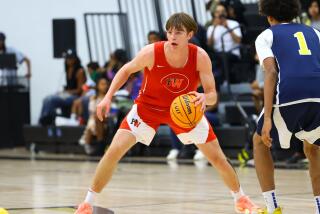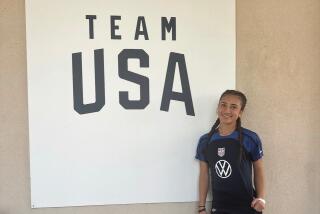Jones Does It All for Santa Clara
With one pass Feb. 22, Santa Clara point guard Brian Jones picked up his 500th assist, to go with the more than 1,500 points and 500 rebounds in his collegiate career.
Jones, a starter for four seasons, already had ranked among some of the top players in the school’s history. On that list are former Laker Kurt Rambis and current Dallas Maverick guard Steve Nash.
But his combination feat took on greater significance when Oakland Tribune writer Jeff Faraudo researched the 21 Division I universities in California and found that no other player had accomplished it.
UCLA’s Bill Walton didn’t do that. Neither did USC’s Paul Westphal. Not Cal’s Jason Kidd. Nor Cal State Fullerton’s Leon Wood.
Thousands of players have scored 1,500 points, or grabbed 500 rebounds, or dished out 500 assists. Until now, no one had done all three while playing at a Division I university in California.
“That was kind of mind-bogging,” Jones said. “You look at the players that have played at UCLA, Stanford or all the other universities.
“To be the first guy, the only guy to do that is really something.”
Jones has been a fixture at the point for Santa Clara since the first game of the 1996-97 season. In four seasons, he has started all but one game.
A three-time All-West Coast Conference first-team selection, Jones is the soul of an 18-11 Bronco team that is peaking as it prepares to play Loyola Marymount in the first round of the WCC tournament today at San Diego’s Jenny Craig Pavilion.
“Our program is dictated on what he does for us,” Santa Clara Coach Dick Davey said. “He does so many things to help our team. To be a point guard, you have to be that kind of person who is able to take on many responsibilities and he does everything for us.”
Jones, a City Section player of the year at Wilmington Banning High, isn’t exceptional, despite his honors. He is a 39% shooter and not known as a gifted passer.
But he has averaged 4.9 rebounds over 112 games and has been regarded as one of the conference’s most tenacious defenders. Very simply, hard work makes Jones succeed.
“I’m the first to say I’m not a great shooter or a great passer but I think I have great knowledge of the game and I try to be versatile,” he said. “I have the attitude that you reap what you sow.”
Davey said that attitude rubs off on his teammates.
“He is one of the most competitive players I have ever come across,” he said. “The guy works extra hard. I have nothing but respect for what he puts into the game.”
It is that very trait that brought Jones to this point. After two impressive seasons, the 6-foot-3 guard was looking at stardom and began to envision a career in the NBA.
During a summer league game in the Bay Area, he came downcourt on a fast break and was driving toward the basket. Adonal Foyle of the Golden State Warriors went up to challenge Jones’ shot and collided with him.
Jones was knocked off balance and tried to catch himself with his leg. His left leg buckled underneath him and he knew immediately something was wrong.
“When he hit me, my body went out of control,” he said. “I was still looking at the basket and I was just trying to land on my feet.
“I knew it was pretty severe. It was probably the worst injury you could have had.”
Jones hurt his right knee in nearly every way possible. He broke his kneecap and suffered tissue and nerve damage to the point that major reconstructive surgery was required.
It took 18 months of rehabilitation just to get the knee back into any kind of playing shape. There were many times when the senior wondered if he could play again.
“I kind of felt sorry for myself at first,” he said. “I did pretty well for two years and I figured I’d have two more years and be in the NBA.
“It was kind of discouraging. A lot of doctors told me it would be really hard to come back if at all.”
With the constant help of Bronco trainer Mike Cembellin, Jones worked and worked through his medical redshirt year until he was ready for fall practice before the 1999-2000 season.
In the opener against Pacific, Jones was back in the starting lineup.
“The injury was tremendously severe,” Davey said. “To his credit, he worked his way back.
“Last year, he was a little tentative with his knee. This year, he’s a little more confident.”
And now, the player who replaced Nash is about to pass him by. Jones is only four assists shy of the record 510 set by the point guard from 1992-96.
But Jones, who was largely overlooked by Southland universities out of high school, has a higher goal. Despite a 71-44 record while he has been in the lineup, the Broncos have not advanced to the NCAA tournament.
Under Nash, Santa Clara went three times and won two games. To advance, Jones knows he has to get the third-seeded Broncos past probable obstacles Gonzaga and Pepperdine in the WCC tournament.
Last week, Santa Clara showed the task isn’t impossible by defeating Gonzaga, 84-71, ending the Bulldogs’ nation-leading 14-game win streak.
“There’s more of a sense of urgency for the seniors,” he said. “I came here because they went to the NCAA tournament and I liked what the program did for guards like Steve Nash.
“Since I’ve been here, I’ve wanted to get in the tournament and it’s really important that we try to make a run at it.”
(BEGIN TEXT OF INFOBOX / INFOGRAPHIC)
Select Circle
Santa Clara’s Brian Jones is in an elite group of NCAA Division I players with more than 1,500 points, 500 rebounds and 500 assists in their careers. Some of the players who have accomplished the feat:
*--*
Player School Years Pts. Reb. Ast. Danny Ainge BYU 1977-81 2,467 541 539 Craig Claxton Hofstra ‘96-2000 2,015 566 660 Johnny Dawkins Duke 1983-86 2,537 536 555 Danny Ferry Duke 1985-89 2,125 1,003 506 Brian Jones Santa Clara ‘96-2001 1,666 560 506 Charles Jones Rutgers-LIU 1994-98 2,428 510 503 Andre Miller Utah 1995-99 1,618 643 721
*--*
NOTE: Assists didn’t become an official NCAA statistic until 1983-84. Most schools didn’t compile assist records until the 1970s.


